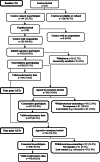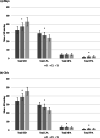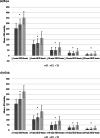Volume and accumulation patterns of physical activity and sedentary time: longitudinal changes and tracking from early to late childhood
- PMID: 33731102
- PMCID: PMC7971959
- DOI: 10.1186/s12966-021-01105-y
Volume and accumulation patterns of physical activity and sedentary time: longitudinal changes and tracking from early to late childhood
Abstract
Background: Physical activity (PA) decreases and sedentary time (SED) increases across childhood, with both behaviours tracking. However, no studies have examined how accumulation patterns of PA and SED (i.e., prolonged bouts, frequency of breaks in sedentary time) change and track over time. The aim of this study was to investigate longitudinal changes in and tracking of total volume and accumulation patterns of SED, light-intensity PA (LPA), moderate-intensity PA (MPA), vigorous-intensity PA (VPA) among boys and girls.
Methods: In 2008/09 (T1), children in HAPPY (3-5y; n = 758) in Melbourne, Australia wore ActiGraph GT1M accelerometers to objectively assess SED, LPA, MPA and VPA. This was repeated at age 6-8y (T2; n = 473) and 9-11y (T3; n = 478). Ten pattern variables were computed: bouts of ≥ 5-, ≥ 10-, ≥ 15- and ≥ 20-min for SED, ≥ 1- and ≥ 5-min for LPA, ≥ 1-min for MPA, ≥ 1- and ≥ 5-min for VPA, and breaks in SED (interruptions of > 25 counts 15 s- 1). Longitudinal mixed models examined changes from T1-3, controlling for T1 age. Generalized estimating equations assessed tracking over the three time points, controlling for T1 age and time between measurements. Analyses were stratified by sex.
Results: Total volume and bouts of SED and SED breaks increased, while total volume and bouts of LPA decreased for both sexes. There was a small decrease in total volume of MPA for girls, but time spent in ≥ 1-min bouts increased for both sexes. Total volume of VPA increased for both sexes, with time spent in ≥ 1-min bouts increasing for boys only. All volume and pattern variables tracked moderately for boys, except for all SED bouts ≥ 15-min, LPA bouts ≥ 5-min and MPA bouts ≥ 1-min (which tracked weakly). For girls, total SED and SED bouts ≥ 1-min tracked strongly, total volume of LPA, MPA and VPA, ≥ 5- and ≥ 10-min SED bouts, and ≥ 1-min LPA and MPA bouts tracked moderately, and SED breaks, all SED bouts ≥ 15 min, LPA bouts ≥ 5 min and all VPA bouts tracked weakly.
Conclusions: Patterns of SED and PA change from early to late childhood; with the exception of SED breaks and VPA, changes were detrimental. Total volumes and short bouts tended to track more strongly than longer bouts. Interventions to prevent declines in PA and increases in SED are important from early in life.
Keywords: Longitudinal; Physical activity; Preschool; School‐aged; Sedentary behaviour; Stability.
Conflict of interest statement
The authors declare that they have no competing interests.
Figures





Similar articles
-
Changes in volume and bouts of physical activity and sedentary time across early childhood: a longitudinal study.Int J Behav Nutr Phys Act. 2019 May 14;16(1):42. doi: 10.1186/s12966-019-0805-6. Int J Behav Nutr Phys Act. 2019. PMID: 31088455 Free PMC article.
-
Change in objectively measured physical activity during the transition to adolescence.Br J Sports Med. 2015 Jun;49(11):730-6. doi: 10.1136/bjsports-2013-093190. Epub 2013 Nov 22. Br J Sports Med. 2015. PMID: 24273308 Free PMC article.
-
Physical activity levels among children attending after-school programs.Med Sci Sports Exerc. 2008 Apr;40(4):622-9. doi: 10.1249/MSS.0b013e318161eaa5. Med Sci Sports Exerc. 2008. PMID: 18317385
-
Objectively Measured Physical Activity, Sedentary Behavior, and Metabolic Syndrome in Adults: Systematic Review of Observational Evidence.Metab Syndr Relat Disord. 2019 Feb;17(1):1-21. doi: 10.1089/met.2018.0032. Epub 2018 Sep 29. Metab Syndr Relat Disord. 2019. PMID: 30272527
-
Infants' and toddlers' physical activity and sedentary time as measured by accelerometry: a systematic review and meta-analysis.Int J Behav Nutr Phys Act. 2020 Feb 7;17(1):14. doi: 10.1186/s12966-020-0912-4. Int J Behav Nutr Phys Act. 2020. PMID: 32028975 Free PMC article.
Cited by
-
Trajectories of physical activity and sedentary time in Norwegian children aged 3-9 years: a 5-year longitudinal study.Int J Behav Nutr Phys Act. 2022 Jun 11;19(1):67. doi: 10.1186/s12966-022-01286-0. Int J Behav Nutr Phys Act. 2022. PMID: 35690755 Free PMC article.
-
Investigating young children's physical activity through time and place.Int J Health Geogr. 2024 May 14;23(1):12. doi: 10.1186/s12942-024-00373-8. Int J Health Geogr. 2024. PMID: 38745292 Free PMC article.
-
Day-level associations of physical activity and sedentary time in mother-child dyads across three years: a multi-wave longitudinal study using accelerometers.J Behav Med. 2022 Oct;45(5):702-715. doi: 10.1007/s10865-022-00335-0. Epub 2022 Jun 26. J Behav Med. 2022. PMID: 35753007 Free PMC article.
-
Sport participation, weight status, and physical fitness in French adolescents.Eur J Pediatr. 2024 Dec;183(12):5213-5221. doi: 10.1007/s00431-024-05796-w. Epub 2024 Oct 1. Eur J Pediatr. 2024. PMID: 39354223
-
Physical activity in young children across developmental and health states: the ActiveCHILD study.EClinicalMedicine. 2023 May 25;60:102008. doi: 10.1016/j.eclinm.2023.102008. eCollection 2023 Jun. EClinicalMedicine. 2023. PMID: 37251626 Free PMC article.
References
Publication types
MeSH terms
LinkOut - more resources
Full Text Sources
Other Literature Sources
Medical
Miscellaneous

